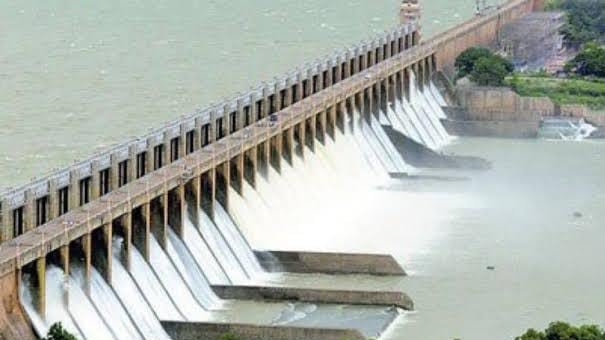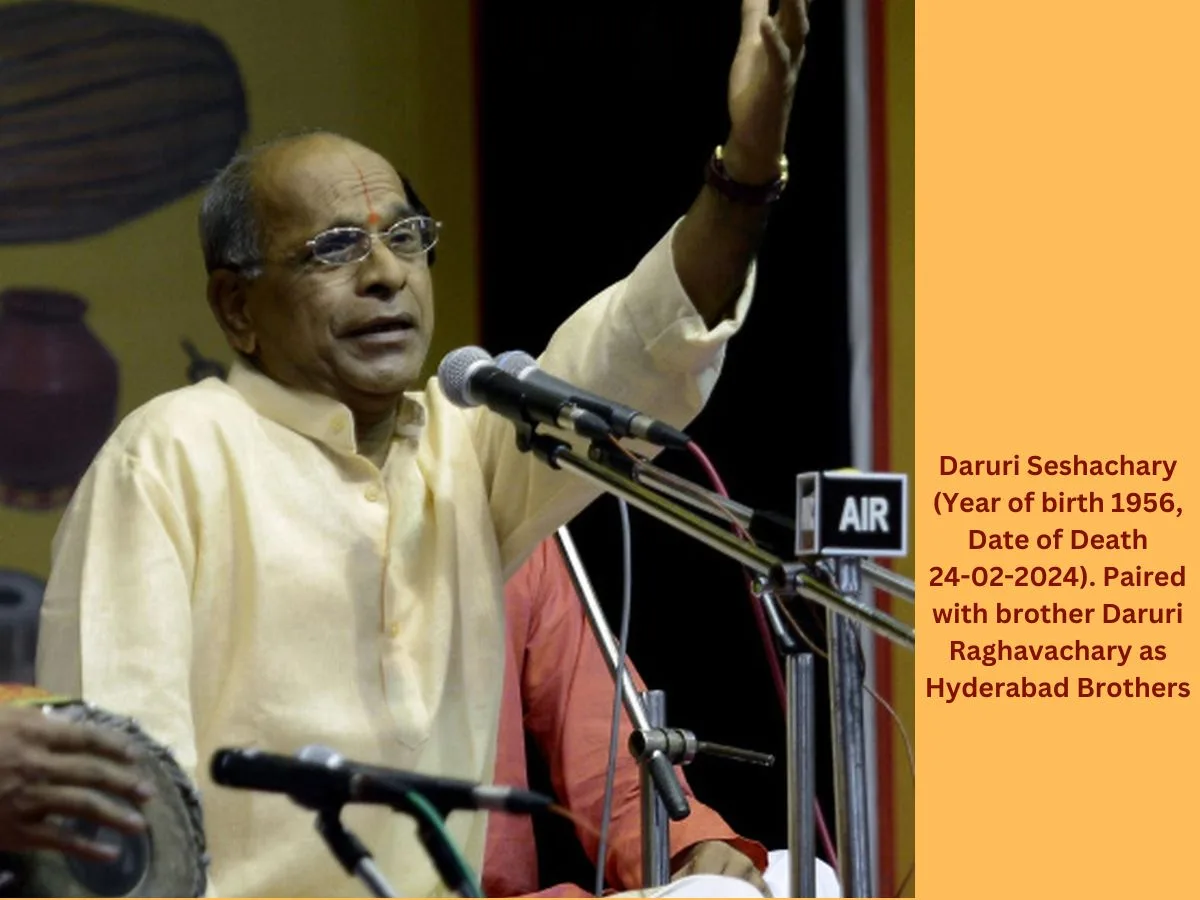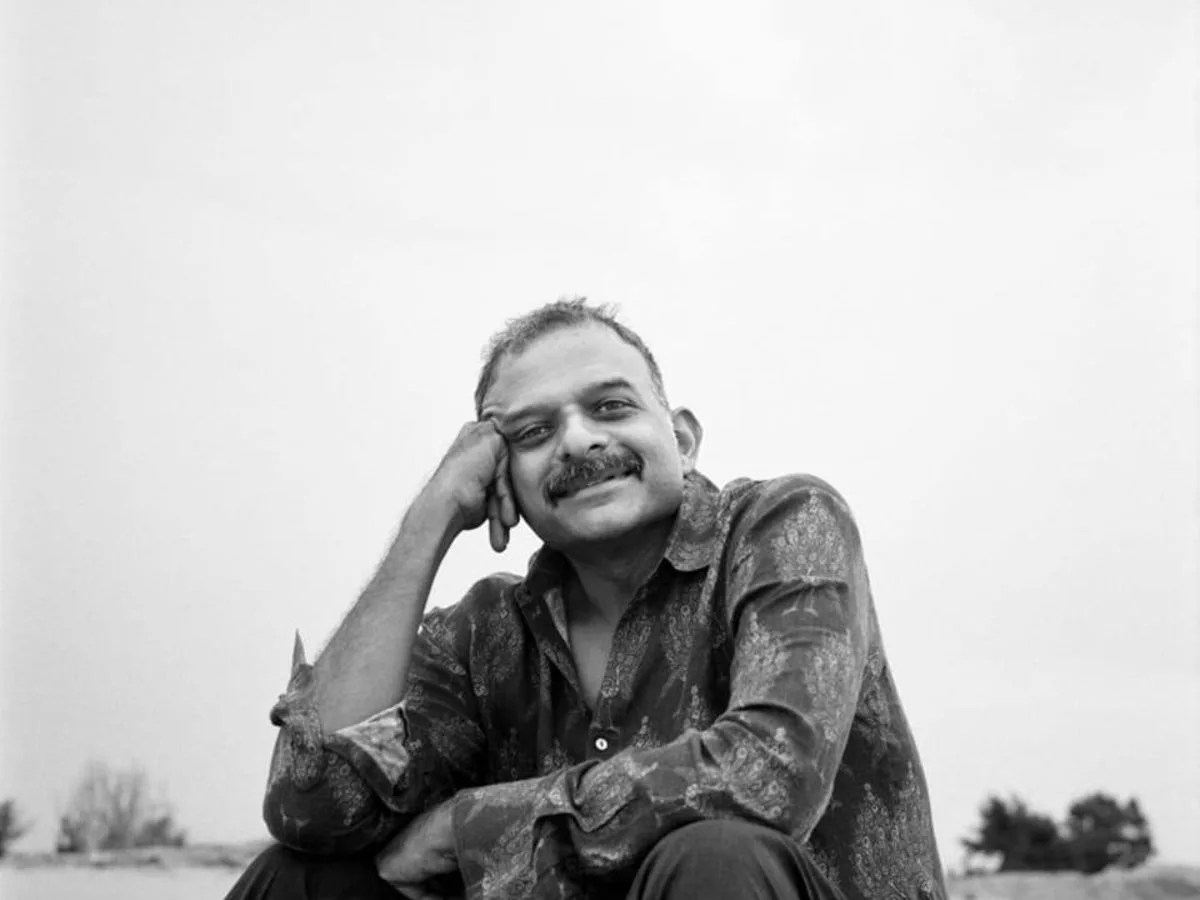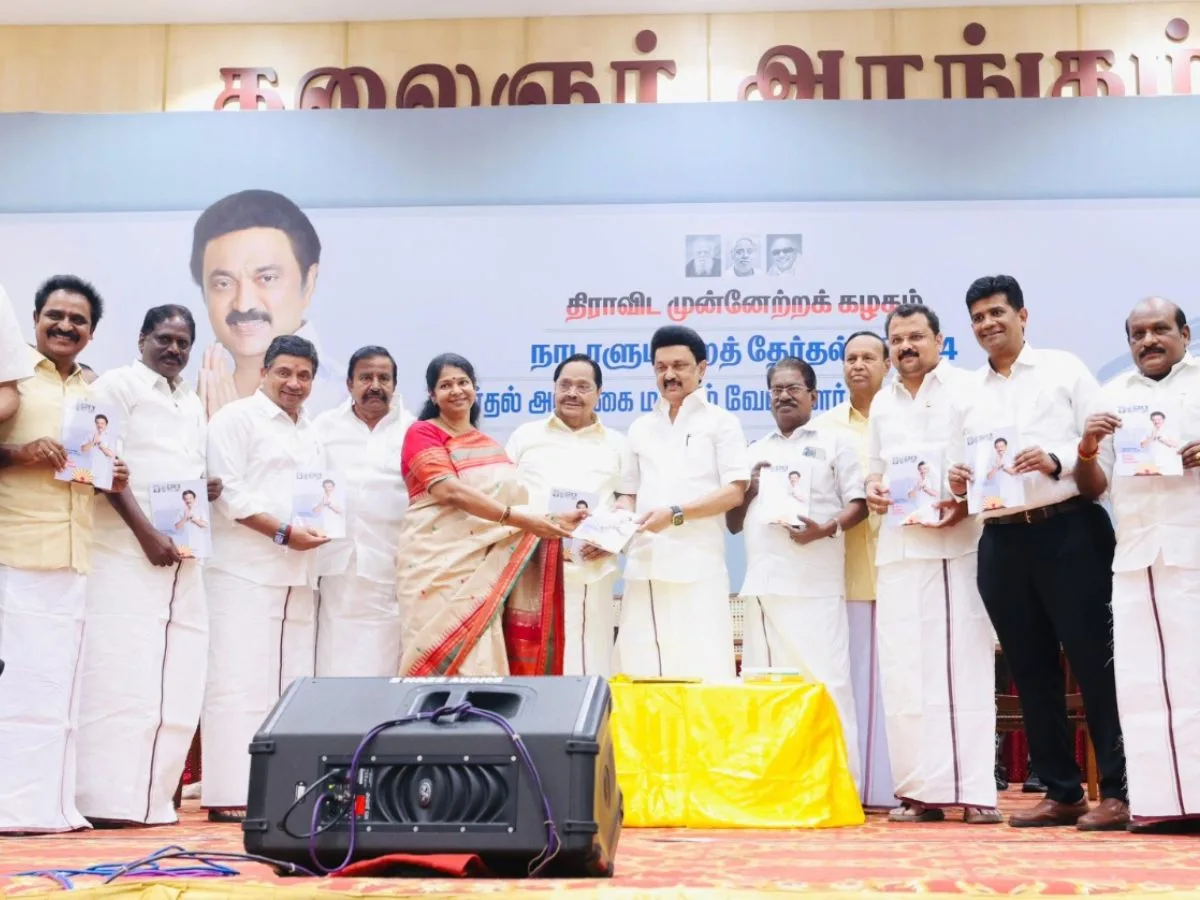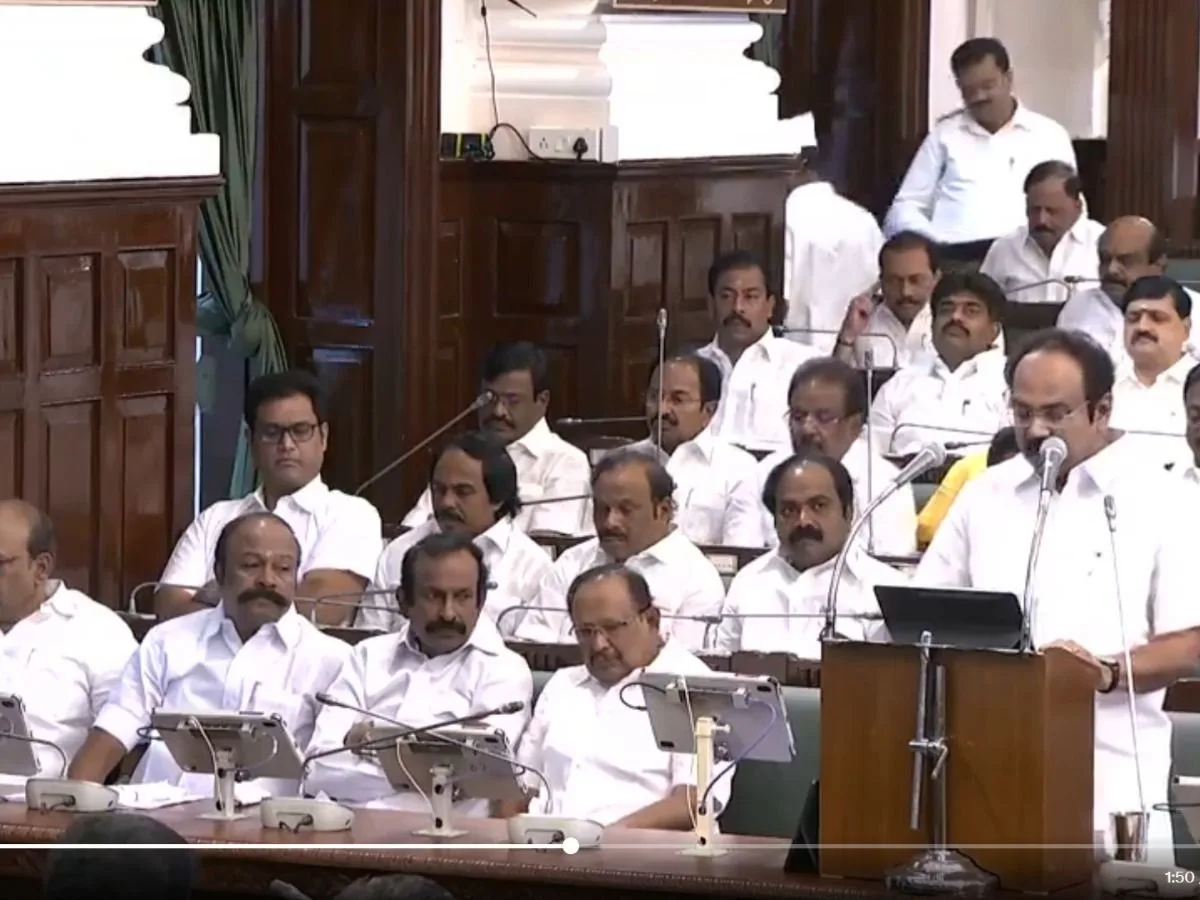Read in : தமிழ்
Consider this scenario: The Krishnaraja Sagar (KRS) reservoir built across the Cauvery river in Mandya district has only 97.91 feet of water against the usual level of 121 feet when the flow of Cauvery trickles down to a few hundred cusecs per day in December against a lakh and more cusecs during the peak monsoons in July. (Full Reservoir Level- FLR is 121.80 feet) This has happened many times in the past. Just because the south-west monsoons have been heavy and the KRS dam has received copious inflow this year, it does not mean it will not happen again. A classic case was in 2011, Cauvery watchers recall, when the dam lost water rapidly.
Scenario II: Even at FRL level, the Supreme Court order to Karnataka to release 10,000 cusecs of water to Tamil Nadu till December 10 adds up to a total of 4.8 TMC. A further 12.8 TMC is reserved for agriculture to irrigate 11 lakh hectares to complete the kharif cultivation and 8 TMC for drinking water for cities like Bangalore, Mysore and Mandya till the onset of monsoons 2023. The inflow into the reservoir hovers around 3,000 cusecs per day while the outflow was pegged at 5,140 cusecs per day into the channels and the river course, which means the reservoir was already losing 2,140 cusecs every day from the reserve. If the KRS was to release 10,000 cusecs per day till 10 December, the reservoir will be left with just 16 TMC of water out of which 4 TMC is dead storage and no water can be drawn from the reservoir once storage level reaches dead reservoir levels (DRL).
These scenarios serve as ready reckoners for experts in Mandya, Mysuru and Bengaluru districts who point out that good monsoons are not an indicator of abundant water supply throughout the year for the region.
T.S. Satyananda, well-known advocate and a former member of the legal committee, shared his findings exclusively with inmathi.com and said: “The gauge at Biligundlu (a village on the border of Tamil Nadu and Karnataka) typically shows a reading in the third week of October in a typical monsoon, that the southern course of the Cauvery is getting 18,000 cusecs of water per day flowing into Mettur dam 55 kilometres from Biligondlu and further into the Bhavani Sagar dam 150 kilometres south of Mettur.”
Satyananda further said that considering the excess monsoon rainfall so far in 2023, both Mettur and Bhavani Sagar will reach their Full Reservoir Level (FRL) in the next one week. However, “Tamil Nadu has been diverting water through its network of canals and filling up check dams and tanks in Thanjavur and other districts just to prevent the reservoirs from reaching their FRL; Irrigation Department of that state is maintaining the levels at both reservoirs three feet below FRL to strengthen its case in the Supreme Court,” he said.
Experts in Mandya, Mysuru and Bengaluru districts who point out that good monsoons are not an indicator of abundant water supply throughout the year for the region
Records available with the Karnataka Water Resources Department updated on July 30, 2022 state that in a typical monsoon inflow, the Karnataka government releases 31,000 cusecs of water to Tamil Nadu in October every year for more than 12 days. It adds up to a total of 30 TMC in a typical monsoon year as against the Cauvery Monitoring Committee recommendation of 27 TMC. This excess water is actually Karnataka’s share, experts from that state argue.
L. Sandesh, an authority on the history of the Cauvery river water dispute between Karnataka and Tamil Nadu, said, “Karnataka has suffered over 200 years due to its row over Cauvery river water sharing with Tamil Nadu.”
Also Read:
Mekedatu: Is there something called surplus in Cauvery?
Cauvery in spate: Is just Mettur dam enough?
Sandesh, who has authored a book in Kannada, Cauvery Kadana, said, “This legacy is continuing even after 200 years and today’s situation of Karnataka pertaining to the Cauvery water sharing was nothing better than what it had been 200 years back. The Madras Presidency under the British government had also signed a pact with the Karnataka province in 1924 which was in force till 1974.
The Karnataka government in 1948 after Independence had sought the cancellation of all agreements that the British government had authored on water sharing between two states but the Tamil Nadu government had sought a court order to retain the spirit of the 1924 agreement, again after the creation of Karnataka, the state government wanted the cancellation of the 1924 agreement on the ground that Karnataka was separated from the erstwhile Madras Presidency and was an independent state and a new agreement had to be scripted taking into consideration the new status of the Karnataka state. But the Tamil Nadu government stuck with the old agreement.
Sandesh further explained: “The Kaveri Tribunal award seems to have taken a near-final amount for a normal water year of 740 TMC which even included environmental consideration of flow. But, some basic questions on the analytical aspect remain for the common people, including me. And also on the subject of excess water utilisation vis-a-vis respective State’s contribution to the river system. Firstly, let us analyse how the present award operates: The award stipulates 404.25 TMC to Tamil Nadu, 284.75 TMC to Karnataka, 30 TMC to Kerala and 7 TMC to Puducherry in a Water Year, This will add up to the total of 726 TMC. The balance quantity of about 14 TMC is set aside on environmental considerations.
“Let us consider the case of Karnataka, which contributes 425 TMC, or 54%, to the river system. Of this, if Karnataka utilizes its share of 284.75 TMC, the State will be left with only 140.25 TMC of water. It will not then be possible to let 177.25 TMC at Biligundlu Gauge point to TN. Then where Karnataka should make good for the balance of 37 TMC of water to fulfil the Tribunal’s obligation to TN? There could be two choices either it should sacrifice its water share to that extent or it should not utilize Kabini waters, as received from Kerala. Neither Kabini nor any of its tributaries flows even to an inch in TN but flow fully only in Karnataka. How fair it is then to deprive Karnataka of a major share in Kabini Waters is a valid question,” asks Sridhar Raghunatha Rao, an authority on the Cauvery river sharing.
“In other words, if 177.25 TMC is to be let out at Biligundlu, Karnataka can enjoy only 247.75 TMC against our full allocated share of 284.75 TMC. Secondly, let us now see the case of Tamil Nadu. With the generation of 252 TMC, at 32 percent in addition to 177.25 TMC let by Karnataka at Biligundlu, the total would add to 429.25 TMC. If we deduct 7 TMC, the share of Puducherry, from 429.25 TMC, TN will still be left with 422.25 TMC of waters. There will thus be an excess volume of water to the extent of 18 TMC left with Tamil Nadu even after enjoying its full share of 404.25 TMC of water. This is not at all fair for Karnataka,” Rao said.
Sandesh recalled that “even when the KRS was built, the Karnataka government was made to run from pillar to post for 13 years to just to propose the construction of the KRS reservoir.”
According to the figures in his book, Karnataka has already released over 6,000 TMC of water since KRS came up, of which Tamil Nadu has used only a fraction and the rest has been allowed to flow into the Bay of Bengal. The farmer leaders and government functionaries in 1972 had proposed the construction of another dam at Mekedatu closer to the Tamil Nadu border under the Karnataka-Tamil Nadu joint venture with participation from the central government but the dam had not come up due to political reasons which is what has caused the frequent eruption of a dispute between the two states over water sharing,” Sandesh insisted. He formed the Devaraj Urs Backward Classes Association through which he tried to impress the state governments to construct the Mekedatu to resolve the dispute from Karnataka’s point of view.
Over 9 lakh hectares are irrigated by the Cauvery river water for growing ragi, sugarcane and paddy in the river basin for which Tamil Nadu is equipped with irrigation infrastructure comprising mainly 75 dams, 10,540 tanks and 4,429 km of canals, that have been created to meet the water requirement of nearly 33 lakh hectares of gross irrigated area in the State. According to sources in the Cauvery Monitoring Committee, Tamil Nadu has one of the best irrigation and water augmentation facilities among the southern states. The situation is buffered by October-January north-eastern monsoons, in addition to the Cauvery river inflow from Karnataka which gets water from the south-western monsoons.
Given the rains so far, the experts hope that the KRS reservoir will reach its full level (124.80 ft) by end of August or latest by the first week of September, but with Tamil Nadu renewing its demand of 46 TMC of water with the central government, the reservoir might lose water rapidly. Usually, the water sharing calendar begins sometime in September and goes on till December when Karnataka would have released Tamil Nadu’s share of water.
According to the TN Agriculture Department, the short-term kuruvai paddy in the Cauvery Delta has been yielding a good harvest following the state’s immaculate water augmentation and distribution system. Preparations for the kuruvai crop has reached its third stage of operations in the beginning of June 2022. The Mettur dam (Stanley reservoir) is now able to provide water for karuvai operations this year. This means that the entire farming community in the Cauvery Delta spread across the four fertile districts along the river is in for a major harvest in October. The kuruvai is cultivated on more than five lakh acres in the districts of Thiruvaroor, Tiruchi, Nagapattinam, Thanjavur and parts of Cuddalore.
Water is released from Mettur Dam on June 12 every year which sustains the kuruvai crop. Since Karnataka has released enough water till July 30 the dreams of farmers in Tamil Nadu have begun to look up. The Mettur Dam can be opened only if the water level is above the 90 ft mark. This mark was reached once in June and twice in July this year. Even in the first week of August, the reservoir maintained that level, Karnataka officials pointed out.
Given the rains so far, the experts hope that the KRS reservoir will reach its full level (124.80 ft) by end of August or latest by the first week of September, but with Tamil Nadu renewing its demand of 46 TMC of water with the central government, the reservoir might lose water rapidly
The Cauvery Delta Farmers’ Welfare Association has blamed the Centre for its failure to constitute the Cauvery Water Management Board as per the directive of the Cauvery Water Dispute Tribunal.
Farmer leaders in the Cauvery Delta Farmers’ Association and the entire farming community in Tamil Nadu wanted the government to act fast in constituting a centrally-managed Cauvery Water sharing mechanism with experts from Karnataka, Tamil Nadu and Kerala at a time when the rains are at peak and the augmentation of water was at its best in both Tamil Nadu and Karnataka.
The Consortium of Indian Farmers Associations (CIFA), has studied various inter-state water sharing protocols in Uttarkhand, Assam, Bihar, Bengal and Odisha which also receive heavy rains but lack the augmentation and canal network of Tamil Nadu.
The Centre For Climate Change at Periyar Maniammai University, Thanjavur in an expert opinion, said that there was surplus water in all the rivers of Karnataka with the Netravati, Hemavathi and Harangi rivers all overflowing and the surplus water discharged into the Arabian sea. It would have been possible for the state to to divert the water to the Cauvery through a series of link canals. The National Water Development Authority (NWDA) under the Ministry of Water Resources has finalised a proposal to divert surplus water from the Netravati basin to the water-deficient Cauvery basin in Tamil Nadu.
Read in : தமிழ்
